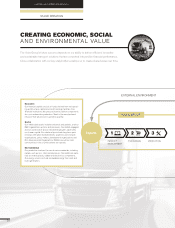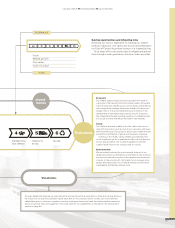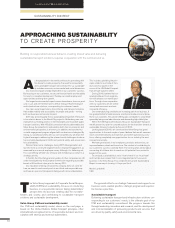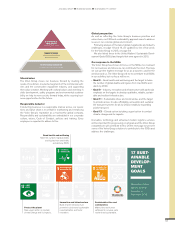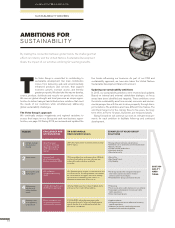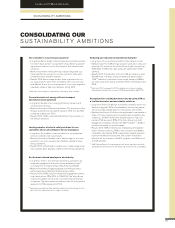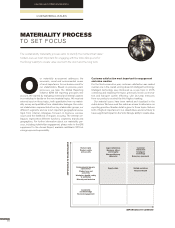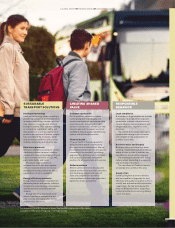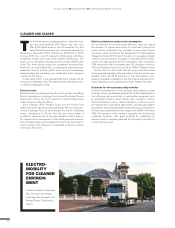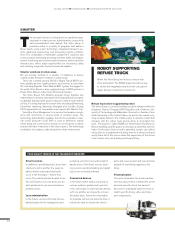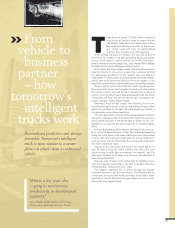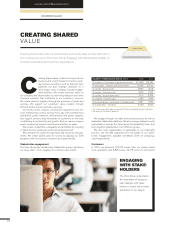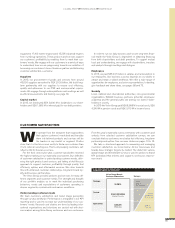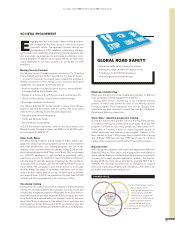Volvo 2015 Annual Report Download - page 62
Download and view the complete annual report
Please find page 62 of the 2015 Volvo annual report below. You can navigate through the pages in the report by either clicking on the pages listed below, or by using the keyword search tool below to find specific information within the annual report.
A GLOBAL GROUP BUSINESS MODEL SUSTAINABLE TRANSPORT SOLUTIONS
The Volvo Group has a leading position in hybrid technol-
ogy and electromobility. Volvo Buses has sold more
than 2,300 hybrid buses in over 20 countries. The first
Volvo Electric Hybrid went into commercial operation in
Hamburg in December 2014, followed by Stockholm in 2015.
In June 2015, bus route 55 opened in Gothenburg, with three
completely electric buses and seven electric hybrid buses. The
buses run on renewable electricity and are energy efficient, and
silent. The three electric buses are completely emissions-free.
Route 55 is a result of ElectriCity, a collaborative project between
academia, industry and the public sector aimed at developing,
demonstrating and evaluating new sustainable public transport
systems for the future.
In December 2015, it was decided that Volvo hybrids will be
introduced in Mumbai, India. The hybrids will be manufactured in
our facility in Bangalore, India.
Electric trucks
Renault Trucks has developed two all-electric vehicles: the Maxity
Electric operating on a hydrogen fuel cell and the Renault Trucks
D all-electric. These two truck models are currently being tested
under actual operating conditions.
Since February 2015, Renault Trucks and the French Post
Office have been operating a Renault Maxity Electric truck pow-
ered by a hydrogen fuel cell which doubles the vehicle’s operating
range, extending it to 200 km. This fuel cell solution makes it
possible to overcome two of the major limitations which have so
far hampered the development of electrically-powered vehicles:
their operating range and recharging time, since the time taken to
refuel a vehicle with hydrogen is comparable to that of a vehicle
running on diesel fuel.
Vehicle solutions to reduce fuel consumption
Our commitment to fuel and energy efficiency does not stop at
the driveline. To improve even more, it is essential to look at the
whole vehicle combination. For a number of years, Volvo Trucks
has been actively involved in the development of High Capacity
Transport vehicles (HCT). One of the aims is to develop a modular
system for forest transport. Compared to standard 60-ton combi-
nations, the high-capacity 90-ton combinations have achieved a
22% reduction in fuel consumption and CO2 emissions, while the
74-ton combinations have reduced CO2 by 10% to 15% per ton-km.
Another aim is to test trucks that are longer and heavier than
those generally available in Europe today. So far, the vehicle com-
bination shows 20–25 % reduction in fuel consumption, com-
pared to standard combinations and that volume and load distri-
bution may play a more significant role than weight restriction.
Solutions for off-road heavy-duty vehicles
Continued development of new drivetrain and hydraulic system
solutions shows considerable potential for further optimization of
fuel efficiency and productivity in construction equipment such
as articulated haulers, wheel loaders and excavators. Various
technical solutions such as electro-hydraulics, continuous varia-
ble transmissions and hybrid approaches, including grid plug-in
possibilities, may yield significant energy efficiency contributions.
In these cases, potential reduction ranges from 20% to more than
50%. The functions of the machine, especially the electronically
controlled functions, offer great potential for optimizing the
machine itself, its operation path and the efficiency with which its
components are used.
CLEANER AND LEANER
ELECTRO-
MOBILITY
FOR CLEANER
ENVIRON-
MENT
Concrete solutions to decrease
CO2 emissions are already
underway. One example is the
Renault Trucks D all-electric
vehicle.
60


